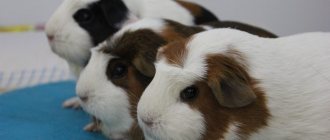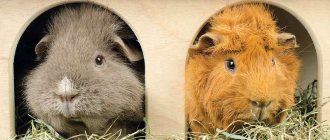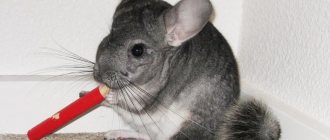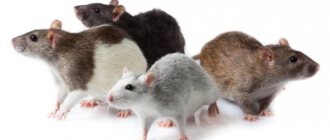Rodents are often kept as pets for children. But rats are one of those animals that quite adult, adequate people willingly keep at home. Simply because they fell in love with these animals. Before buying a pet, you should weigh all the pros and cons of pet rats. A living being is a great responsibility. Perhaps, after reading this article, you will prefer to get another rodent (for example, a guinea pig) or even wait until “adding.” I became infected with rat mania as a child. Although there are no rats living in my house now, I still hope that the children will grow up and help me persuade my husband to get a couple of rats. I promise to tell you about the disadvantages of decorative rats. After all, rave reviews from rat breeders on the Internet are not very helpful. It is the shortcomings and content issues that should be of interest to a beginner in the first place. Well, if they don’t scare you, welcome to the society of rat lovers.
Author of the article: Olga Shiltsova, practicing veterinarian, author of the books “Dachshund of Fate” and “Tails of Fortune”
The main advantages of keeping a rat
Fortunately, the advantages of decorative rats are much greater than the disadvantages. Below are listed only the main positive qualities of the animals.
High socialization
Rats do not tolerate loneliness very well; they prefer to live in small same-sex groups. At the same time, animals show care for their relatives:
- brush each other's fur coats;
- feed weakened individuals;
- show sympathy;
- warn of impending danger.
Fights and conflicts between rats are a very rare phenomenon, which is observed mainly in males during sexual activity.
High cognitive abilities
Contrary to popular belief, rats are very smart. Their intellectual abilities are on par with cats and dogs. Rodents remember their name well and are easy to train.
Fluffies can be taught on their own such commands as “give me a paw”, “lie down”, “come to me”. Rats also perform simple tricks - walk on their hind legs, roll a ball, spin around their own axis, jump from place to place.
Easy to care for
The cute fluffies are quite easy to care for. Difficulties may arise at first, but the main thing is to get used to it. By choosing a cage with a removable tray, cleaning takes literally 10-15 minutes.
Sawdust or shredded toilet paper are used as filler. You can feed your rodent either specialized food or natural food. The only caveat is that you need to remember the list of prohibited products.
Doesn't take up much space
Decorative rats are quite compact. Their body length is about 20 cm. Therefore, several individuals can be kept in one multi-tiered cage at once - up to 5-6 pieces. The rat house itself does not take up much space. The cage will easily fit on a desk or bedside table.
Affordable price
The price of a decorative rat, even one raised in the most prestigious nursery, is unlikely to rise above 2,000 rubles. And at the poultry market or by hand you can buy a purebred pet for only 500-700 rubles.
It is better to buy rats from professional nurseries. Because pups raised by experienced breeders are more socialized and healthier.
Easy to transport
Rats tolerate moving well even over long distances. All that is required for comfortable transportation is a special carrier with a secure lock, while ensuring air circulation. The small weight of the animal - within 500 grams - will prevent the owner from getting tired during the trip.
Big choice
There are many breeds of decorative rats, so everyone will find a pet to their liking. Among the varieties there are different animals: compact and bulky, bald and fluffy, with straight and curly hair, with large and small ears, albino and fluffy with complex colors.
Cleanliness
Many people believe that the destiny of rats is to climb through garbage dumps and rummage through garbage. However, ornamental animals are very different from pasyuki. Cute fluffies are very clean.
They perform daily activities to maintain the cleanliness of their body: they wash themselves after each meal and lick their fur. And if several individuals live in a cage, they happily clean each other’s fur coats. In addition, decorative rats love to swim. The owner must take care of organizing water procedures.
Attachment to the owner
Rats quickly get used to their new owner and happily spend time with him. In addition, cute animals gradually get used to the rest of the family members. If a rodent feels good about itself, it will never bite, scratch or run away from home.
Possibility of litter training
Rats are very smart, so they can be trained to go to the toilet in one designated place. This will only require a few trays (according to the number of pets in the cage) and a little patience.
The duration of toilet training is from 2 to 4 weeks. If the rat gets used to the litter box, the process of cleaning the cage will take much less time.
Activity
Decorative rats are very active - they really like to play with their relatives, exercise on apparatus in the cage, and explore everything new. It is very interesting to observe the life of fluffies from the outside. If you have free time, you can spend hours on end watching cute animals frolic.
Since rats are very active, it is better to purchase multi-tiered cages for playful animals. 2-3 floors will be enough for males, 4-5 tiers for females.
No need to spend a lot of time together
Rats love their owners very much and are always willing to play with them. But if the furry owner doesn’t have much time to spend together, it’s okay. Fluffies are able to keep themselves busy - they exercise on apparatus, play, and frolic with their cage neighbors. At the same time, the rodent does not develop any resentment towards humans.
No need to go outside
Other pets, such as cats and dogs, need a lot of space. In addition, such large pets prefer to go to the toilet outside.
With rats everything is much simpler. The little animal feels quite comfortable in a cage. And to release the accumulated energy, a play complex installed in a cage is enough for a rodent.
Types of rat cells
When choosing housing for your rat, remember that the bigger the better. As a general rule, the minimum size for two adult rats should be 75cm wide x 45cm long x 60cm high. The absolute smallest size for a vertical multi-storey cage should be 60cm wide x 35cm diameter x 90cm high. Young rats prefer multi-level cages and can live in slightly smaller spaces. As rats get older, they cannot climb as easily and sometimes lose their grip and fall. As a result, a single-story enclosure is preferable for older rats.
The mesh should be square or rectangular in shape. The rectangles should be large enough for a rat's paw to fit through the hole easily. Unfortunately, many cages are made with a rectangular cell measuring around 30cm by 3cm and should be avoided. Indeed, these types of meshes have a high risk of causing pain to your little rodent friend. The wire should also be powder coated to prevent the cage bars from rusting.
Cons of content
Unfortunately, rats do not have their drawbacks. But the shortcomings of these cute rodents are very minor, and they can be easily dealt with.
Tendency to diseases
Rats have a fairly weak immune system, so fluffies often get sick. In addition, a predisposition to certain diseases is inherent in them at the genetic level. Most often, rodent owners encounter the following ailments of their pets:
- ARVI;
- malignant and benign neoplasms;
- mycoplasmosis;
- atherosclerosis;
- renal failure;
- pneumonia.
Rats also often suffer from fleas, lice, ticks, worms and other parasites.
Short lifespan
On average, rats live about 3 years. Compared to other types of pets, this is a very short period of time. Some varieties of decorative rats, for example, albinos, live only 1.5-2 years. Long-livers are also found among rodents. With proper care and timely treatment, a rat can live up to 4-4.5 years.
Marking territory
Some novice breeders mistakenly believe that only males mark territory. However, females also put their marks everywhere. The only difference is that the urine of male rats has a more pungent, specific odor. Regular cleaning of the cage will help solve this problem.
Unpleasant smell
During the life of a rat, like any other animal, an unpleasant odor is released. And it doesn't just come from excrement or urine. The endocrine glands also emit a specific aroma, to get rid of which you will have to regularly subject your pet to water procedures.
Unpleasant associations
The appearance of rodents, to put it mildly, scares some people away. Some consider cute decorative fluffies to be as aggressive as their wild relatives. And some breeds, for example, the Sphynx, are generally terrifying to especially impressionable people.
Damage to things
As long as the rat is in the cage, its owner’s property is completely safe. But rodents are very agile and are able to open a weak lock on their own. If he escapes, the fluffy will chew everything that gets in his way - furniture, wallpaper, clothes, wires. Therefore, it is recommended to place even a cage with a rat away from walls and any things - otherwise the rat can reach them through the twigs.
Noise at night
Rats are nocturnal animals. Therefore, they often go to bed only in the morning. And at night they stay awake, play, frolic, learn everything new. This feature can cause discomfort to owners, especially if small children live in the house. To ensure that pets do not disturb anyone’s sleep, it is better to place the cage in a separate room.
Aesthetic problems
Adult male rats have very prominent genitals. This is especially noticeable in representatives of short-haired and hairless varieties. This feature is very off-putting or confusing for some people.
Expensive treatment
The health of rats is quite poor; fluffies get sick very often. Therefore, they will have to be treated constantly, paying considerable sums for medical services. Moreover, ordinary veterinarians rarely work with such small animals as rodents. Most likely, you will need to look for a special doctor for rats - a ratologist.
The problem is aggravated by the fact that there is only one specialist for 2-3 cities. Therefore, for treatment, you may have to transport the animal to a neighboring village.
Cleaning the cage
Because ammonia in rat urine can disrupt their sensitive respiratory system, it is important to keep the cage clean. Cleaning is required more frequently for smaller cages and larger groups of rats. If you smell rat urine, it's time to get out!
The litter you choose will determine how often you will need to clean the cage. While some fillers work well, some do more harm than good.
Spot cleaning (removing feces) is a great option compared to full cage cleaning. It is not recommended to clean the cage too often, as the rats will want to smell everything again. Cleaning the cage once a week with spot cleaning every day is a great choice.
Is it worth getting a decorative rat?
Whether it is worth having a decorative rat as a pet is a rather controversial issue. On the one hand, little fluffies have many advantages. And the most important of them is boundless love and affection for the owner. The animal loves to spend time with people, loves to be petted, and enjoys being held. Therefore, rat owners are never bored or lonely.
On the other hand, rats are not without certain disadvantages. Therefore, if you have the desire and ability to cope with difficulties, it is still worth getting a pet. Rats are very smart and sociable, so they are in no way inferior to animals such as cats and dogs.
What should you avoid when choosing a cage?
Here are the most important things to consider before purchasing a rat cage:
- It is better not to buy a cage made from wooden parts. Indeed, liquids (including urine) can become absorbed into the wood, which is difficult to clean.
- Always check for any sharp edges that could injure rats.
- Avoid aquariums! A glass enclosure is not a good place for rats because air cannot flow freely through glass enclosures. Moreover, urine and feces are bound to remain airborne inside the glass container, which can increase the risk of respiratory diseases.
- You should stay away (if possible) from the chicken wire on the cage floor unless you completely cover the chicken wire on the cage floor. If you allow your rat to regularly walk on open chicken wire, your pet may develop a paw infection. Bumblefoot is a bacterial infection and inflammatory reaction that occurs on the soles of rats' feet and is often difficult to treat.
In what cases should you refuse to purchase a rat?
Despite all the positive qualities of decorative rats, in some cases it is still better to refuse to purchase rodents as a pet:
- The family has small children. Rats get along great with kids. But, unfortunately, animals very rarely live longer than 3 years. Therefore, the child will inevitably experience the pain of loss. It is quite difficult for children, especially preschool age, to explain what happened to the pet and where it went. Moreover, situations cannot be ruled out when the furry dies right in front of the child. Particularly impressionable children can receive real psychological trauma.
- Lack of free time. Despite the fact that rats are capable of keeping themselves occupied, they will still need to be given a certain amount of attention every day. In addition to communicating with your pet, you will need to find some time for feeding, cleaning the cage, treating, and bathing the animal. People who often go on business trips should especially give up the idea of getting a rat. Even if you ask a neighbor or friend to care for your pet, the animal will be constantly under stress due to the change of owners.
- At least one family member has allergies. Like any animal covered with fur, a rat can cause severe allergic reactions in the form of skin itching, hives, and swelling. In rare cases, a life-threatening condition such as anaphylactic shock may occur. The only exception is the hairless sphinx rat - it is completely hairless, so it does not cause allergies.
- Presence of cats or dogs in the house. Rats are quite friendly towards other pets. But if the hunting instinct awakens in a larger animal, the rodent will, at best, receive serious injuries. And in the worst case, he will be eaten. If you decide to get a rat, you will need to protect it from potential danger.
Having carefully studied the advantages and disadvantages of a domestic rat, everyone will understand whether it is worth having an animal as a pet. When making a choice, you need to carefully weigh the pros and cons, since an animal is not a toy, but a real family member with whom you will have to spend a lot of time.
Types of cage bedding
Paper filler
As a rule, paper litters are completely safe for your pets. Some types may need to be replaced more frequently as they may clump when wet. Avoid fillers that contain baking soda or fragrances, and avoid products containing words such as “odor control.” Instead, look for words like “natural” or “100% paper.” Paper litters are usually dust-free, making them an ideal choice for rats.
Aspen shavings
Aspen is considered one of the few safe wood bedding areas for rats and other small animals. Unlike softwood, aspen is a hardwood and does not contain the dangerous phenols found in woods such as pine and cedar. Fortunately, aspen is readily available, inexpensive, and virtually dust-free.
Granular filler
Litter pellets are great for use in litter boxes in a rat cage, but you can also use them as bedding throughout the entire cage. While this is not the most convenient option for your rats, it works just as well. Avoid dusty litter or litter containing baking soda. Cat litter or clay litter are not suitable for rats.
Fabric and fleece
Fabric and fleece are great for bedding. They are eco-friendly, washable, reusable, soft and look great! As with anything you put in your rat's cage, always check for loose threads and small parts that may pose a choking hazard. It is important to get into the habit of checking this before and after washing too.
Fleece is known to be the safest fabric for rats because it does not contain threads that can become unraveled and pose a choking hazard. Other tissues can be used but may not be recommended for excessive chewing. Although fleece is safe, it should not be used alone. Fleece does not absorb urine and needs an absorbent layer underneath. It is well known to be machine washable and reusable, so it is important that your rats are bedding accustomed before using fleece as their feces should not be buried in the bedding.
Precautions before fishing
Before catching an uninvited guest, you should take care of your safety:
- wear thick gloves, protect your eyes and respiratory organs;
- set traps away from children and pets;
- remain calm when meeting a live rodent, since a frightened animal is prone to aggression;
- do not touch the animal without personal protective equipment;
- If you are bitten or scratched, thoroughly disinfect the wounds and consult a doctor if necessary;
- bury rats in places inaccessible to other animals.
In outbuildings for poultry and livestock, it is preferable to use mechanical methods of catching: traps, ultrasound, etc.
Diseases
Decorative rats are susceptible to a variety of diseases. Among them:
- infectious (tuberculosis, salmonellosis, tularemia, mycoplasmosis);
- parasitic (lice, fleas, ticks, worms);
- diseases of internal organs (gastritis, bronchitis, pneumonia, pyelonephritis);
- skin (corns, abscesses)
- colds, rhinitis;
- oncological
pet
There are also diseases such as otitis media, periodontitis, and conjunctivitis. Intestinal disorders, diarrhea, and allergies are possible.
Rabies in ornamental rats is extremely rare.
Is it true that they are marking territory?
Many people say that they leave drops of urine everywhere. This behavior is quite normal; rodents in nature have the right to mark their territory.
The fact is that urine contains a huge amount of information that they leave for their relatives.
They not only mark their territory, but also convey information about age, social status, sexual maturity and stress. Marking territory is more common among men, but women are no exception.
During walks, owners often lay out a special fabric to protect carpets and furniture from such “scented” traces.
Sometimes pets urinate on themselves, but this is not due to markings, it is a sign of illness and you should contact your veterinarian. If you skip the labeling issues, they are usually very clean and easy to get used to in the litter box.











